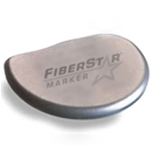Identifying Techniques Using a Laser Marking System
Common Laser Marking & Engraving Techniques
Laser marking systems are capable of producing a wide range of results; from traditional deep engravings to highly contrasting surface marks. All of the results are cosmetically attractive, uniquely identifiable and as permanent as the material it is marked upon.
The Most Common Laser Processing Techniques:

Ablation: Ablation techniques are applied to selectively remove coatings, plating and other surface treatments off of the base part material. The results are often striking; creating great contrast affects. Anodized aluminum, black oxided steel, and painted plastic are just some of the applications for this very appealing method. In these cases the laser marking systems parameters are set to vaporize the top or multiple layers of coatings without harming the base material.
Annealing: Some metals lend themselves to creating a highly contrasting (black) or annealing mark. The laser marking systems parameters are tightly controlled to create a specific temperature for the target metal material to create a heat treatment or carbon migration in the desired marking area. Stainless steel, steels, and titanium are some of the metals that can be successfully processed using this technique.
Bonding: A laser marking technique that uses laser generated heat applied to a part to bond a contrasting additive substance to a wide range of substrates. This technology delivers permanent marks on metals, glass and ceramic parts for a diverse range of decorative and part traceability applications, ranging from aerospace to the awards and engraving industries. It differs from the more widely known techniques of laser ablation, engraving and etching in that it is an additive process, adding material to the substrate to form the marking instead of removing it.
Carbon Migration: is borrowed from welding where carbon migration is considered to be a significant factor in determining the quality of a weld and appears to be a well studied phenomenon. Carbon migration (AIAG Spec B-17) occurs when molecules such as chromium are boiled off during heating and nearby carbon molecules are migrated into the area.
Discolorization: (SAE AS9132) is a laser marking technique used extensively in the marking of plastic substrates. This technique causes the surface
substrate to burn, foam or bubble, causing contrast against the original color of the part. Remarkable color changes can sometimes be achieved in certain plastics, paints and coatings. The laser marking system is used to target the pigments in the material to chemically alter them.
“Discolorization” correctly describes the look of the resulting direct part laser mark compared to the original substrate. “Discolorization” was selected to differentiate this technique from laser colorization bonding techniques. Laser bonding of colored material is typically a patented method that uses materials suspended in a slurry that bind to the surface when heated by the laser beam or instead uses laser enhancers to increase contrast.
Engraving: The engraving process vaporizes the part material down to the depth desired. The laser markers parameters are set to high levels to achieve this result and subsequently processing speeds can be very quick. This technique usually does not have much color change in the part material. You may realize a frosted or darkening effect within the laser mark because the surface area conditions have been changed which will alter any light reflection off of the part. This technique is appropriate for all metals, most plastics, some ceramics, and many other types of materials.
Foaming: Plastics, composites and some paints are often processed using a foaming technique to produce a contrasting, raised laser mark. The laser marker melts the target material itself, which creates gas bubbles that are suspended in the material as it cools. The result is often an attractive white mark against the original darker material.
To learn more about laser marking and engraving, please downloaded our product catalog now.


